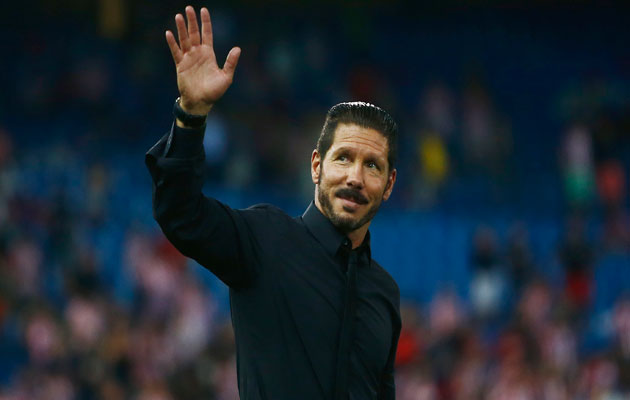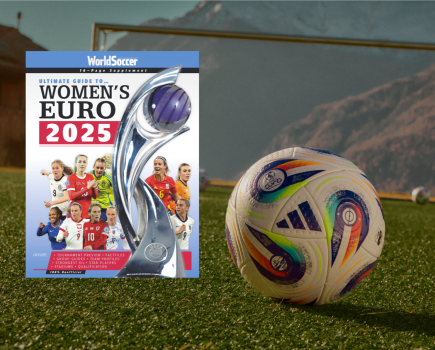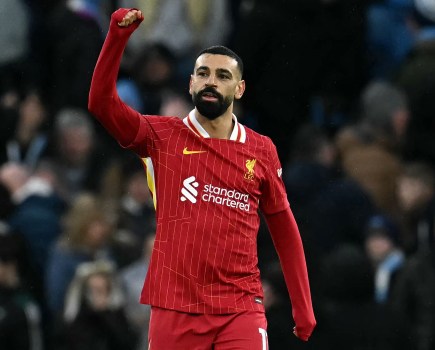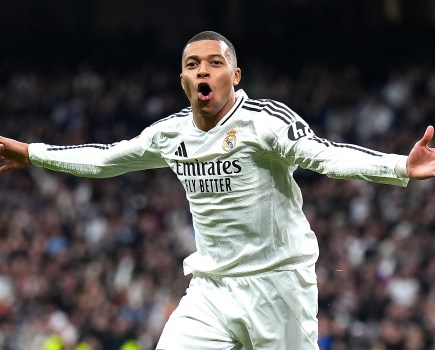There is a single phrase that sums up Diego Simeone; one that condenses the philosophy and attitude that he brings to his teams and what he expects from his players. “Effort is non-negotiable”.
While his career path and his teams reflect this maxim, there is also one single defining moment in his coaching career to date – and that is December 2011, when he took over at Atletico Madrid.
Up until then, his track record had been a sharp and unrelenting learning curve, experimenting with style and formations at a dizzying number of clubs. Since then, it has been one of stability and unprecedented success.
“El Cholo” had always known that Atletico would come calling. He also knew that, when it happened, Atleti would more than likely be in trouble. And so it proved, taking over a side four points off the relegation zone and one that had been knocked out of the Spanish Cup by a team from the third tier.
“When Cholo the coach arrived, everyone was thinking about Cholo the player,” he wrote in his book
The Simeone Effect, with his name conjuring up memories of the club’s last league title, in 1996, when he formed a vital part of Atletico’s midfield.
“Hopefully Simeone is here for a long time,” said sporting director Jose Luis Caminero at the time of Simeone’s arrival as coach. Four years on, he is the second most successful coach in the club’s history.
Simeone has challenged Europe and Spain’s big financial powers and proved it is possible to beat the Barcelona-Real Madrid hegemony. At times, some of his methods and style of play have not won admirers, but the scale of the achievement is such that Simeone is considered by many to be one of the top coaches in world football.
And yet, four years ago neither the club nor the coach offered a guarantee of success nor – crucially – of stability. Simeone’s CV before Atletico reads as a rapid-fire roll call of clubs. Bookended by spells at Racing Club – the Argentinian side he supported as a youngster and where he ended his playing career – he accrued experience with five different clubs in five years.
Simeone ended a long and successful career – with over 100 caps for Argentina and three World Cup finals – at Racing in 2006 and immediately took over as coach with the club facing relegation. Having lost his first game to Independiente in the Avellaneda derby – a game in which a young Sergio Aguero scored twice – it took him seven games to achieve a first win. But although he had been rushed into coaching, he had a clear vision of what he wanted from his teams from the outset.
“Above all, I want my team to have a style,” he told Spanish sports newspaper Marca in 2006.
The style, and the ideas he had picked up as a player, were more modern and varied than those of the older generation of coaches in Argentina, many of whom were still entrenched in decade-old debates over how the game ought to be played. Yet for Simeone, it was quite simple: “The intelligent supporter is the one who does not obsess over whether the team plays well, but rather that the team wants to win.”
While there is no single coach that he most clearly resembles, he has acknowledged such influences as the leadership of Daniel Passarella, the motivation of Alfio Basile, the competitiveness and reading of games of Carlos Bilardo, and Marcelo Bielsa’s intensity and attention to training methods.
Comparisons with Bielsa grew in Argentina thanks to the intensity of his teams – not to mention the intensity of the coach himself on the sideline and his tactical preferences – but Simeone does not fit into the classic line of Bielsa disciples, who include such names as current Argentina and Chile coaches Gerardo Martino and Jorge Sampaoli. But the attention to detail, and the spirit and philosophy in which he speaks in public about his teams, as well as the expectations placed on his players, chimed with much of Bielsa’s philosophy.
What Simeone’s career showed, both before and after Atletico, is versatility given the available resources.
His first job after Racing was at Estudiantes, where he harnessed the recent return to the club of Juan Sebastian Veron alongside Rodrigo Brana in a dynamic midfield partnership. He also played two strikers, Jose Calderon and Mariano Pavone, in a move that reaped its rewards, and there is still graffiti to this day remembering the 7-0 win in the city derby against Gimnasia. There was also an epic title success that saw Estudiantes four points behind Boca with two games to play, before they drew level on points and won the title play-off.
It was Estudiantes’ first championship in decades and Simeone’s first taste of success, but he left for River Plate after just 16 months at the club.
“The collective effort is installed ahead of the individual,” he said on arriving at the Monumental, where he experimented with formations far more than he had done at Estudiantes. Often choosing a 3-3-3-1 to harness the talent of Ariel Ortega, he repeated his success at Estudiantes, winning the title with a team that included Colombia’s Radamel Falcao and a young Chilean striker Alexis Sanchez.
The River Plate experience was also a learning curve. As Simeone still sought to attack and kill off games with a goal rather than closing up in defence, in the 2008 Libertadores Cup quarter-finals his side suffered a famous defeat by San Lorenzo, throwing away victory with a two-man advantage. And just months after winning the title, River ended the following season bottom of the table. Simeone left shortly before the end of that campaign, but he assumed responsibility.
The short season format in Argentina meant that River were not relegated, although that season was the first that ultimately condemned the club to relegation in 2011. But the structure of the game in his home country did magnify a feature of Simeone’s early teams: it was all or nothing – first or last.
It was in part this experience, plus the subsequent clubs he coached, that shaped a more conservative and defensive Simeone. “I prefer to play well than to play attractively,” he said after joining San Lorenzo, who were in disarray at the time. Although he would leave the club no higher than 17th in the table, he did start a process that would turn the club’s fortunes around and lead to their first Libertadores Cup triumph.
His departure saw the media question whether he needed a break, with La Nacion pointing to the pace with which Simeone changed clubs and suggesting that “Mr Vertigo needs a rest”.
Simeone, however, had no intention of stopping. “I haven’t come here hoping to stay in Europe for 10 years,” he said on taking over Catania in Italy. “I came here looking to grow.”
With a squad containing 12 Argentinian players his mission to avoid relegation was accomplished and he would later look back on the Catania experience as a defining one, saying: “At first I always wanted to attack. With time I learnt the best ways to think how to win is in your defensive balance.”
This more defensive Simeone was clear to see when he returned to Racing, with critics despairing at his conservative approach despite having the attacking talents of Colombian pair, forward Teofilo Gutierrez and playmaker Gio Moreno, at his disposal.
His frenetic, constant changing of clubs during this period was mirrored by Atletico Madrid’s approach to coaches and in the five years before Simeone’s appointment five came and went: Javier Aguirre, Abel Resino, Santi Denia, Quique Sanchez Flores and Gregorio Manzano.
By the time Atletico came calling, Siemone had settled on a style that was an ideal for the club’s history: uncompromising, committed, tough, and direct. He was meticulous and would seek every advantage possible. This ranged from checking the horoscopes of potential transfer targets to fighting to make sure Atletico had the same number of ball boys in the Spanish Cup Final against Real Madrid when the Bernabeu was selected as the host stadium.
“We want a team with commitment,” he said of his plans for Atletico. “One that plays, runs, trains, respects the rival, and understands the intelligence in the game.” And his blueprint gave spectacular results. He took over with Atletico 10th in the table, but just four points off the relegation zone. Within five months they ended the season fifth and won the Europa League, beating Athletic Bilbao and his former international coach Bielsa in the Final.
Then came the European Super Cup, then the Spanish Cup, then the league title and then the Spanish Super Cup. Five trophies put Simeone behind only Luis Aragones as the most successful coach in the club’s history.
Much of Simeone’s success as a coach has been down to his ability to get the best out of his players.
Falcao excelled under him at both River and in Spain, while Juanfran, Antoine Griezmann and Koke have all improved at Atletico in terms of performance levels.
Yet he also does not look to improve players’ weaknesses, explaining that “a player must play the way he knows best and that way he will believe he is better than he is”. He also insists on building team camaraderie without forcing the issue. So, for example, at meal times he wants his squad sitting at one vast table “face to face”, rather than divided into groups on smaller tables. His man- management has not only brought out the best in his established players, but also helped youngsters to break through.
Luciano Vietto, who he recently signed for Atletico, was given his first-team debut by Simeone.
Having signed a new contract that runs until 2020, Simeone has given a clear indication to his players that he has little reason to leave Atletico. “Only Bayern, Real Madrid, Chelsea and Barcelona are better than us,” he told Argentinian television recently.
But Simeone is conditioned by Atletico’s resources, which are not in the same category as those clubs he mentions. Internazionale and Lazio are among those who are likely to come calling at some point, and he is also taking English classes.
“I want to coach until I am 65,” he told El Grafico when asked about the national team job.
“And if that happens when I am 60, then great.”
By Joel Richards
This article appeared in the July 2015 issue of World Soccer.







